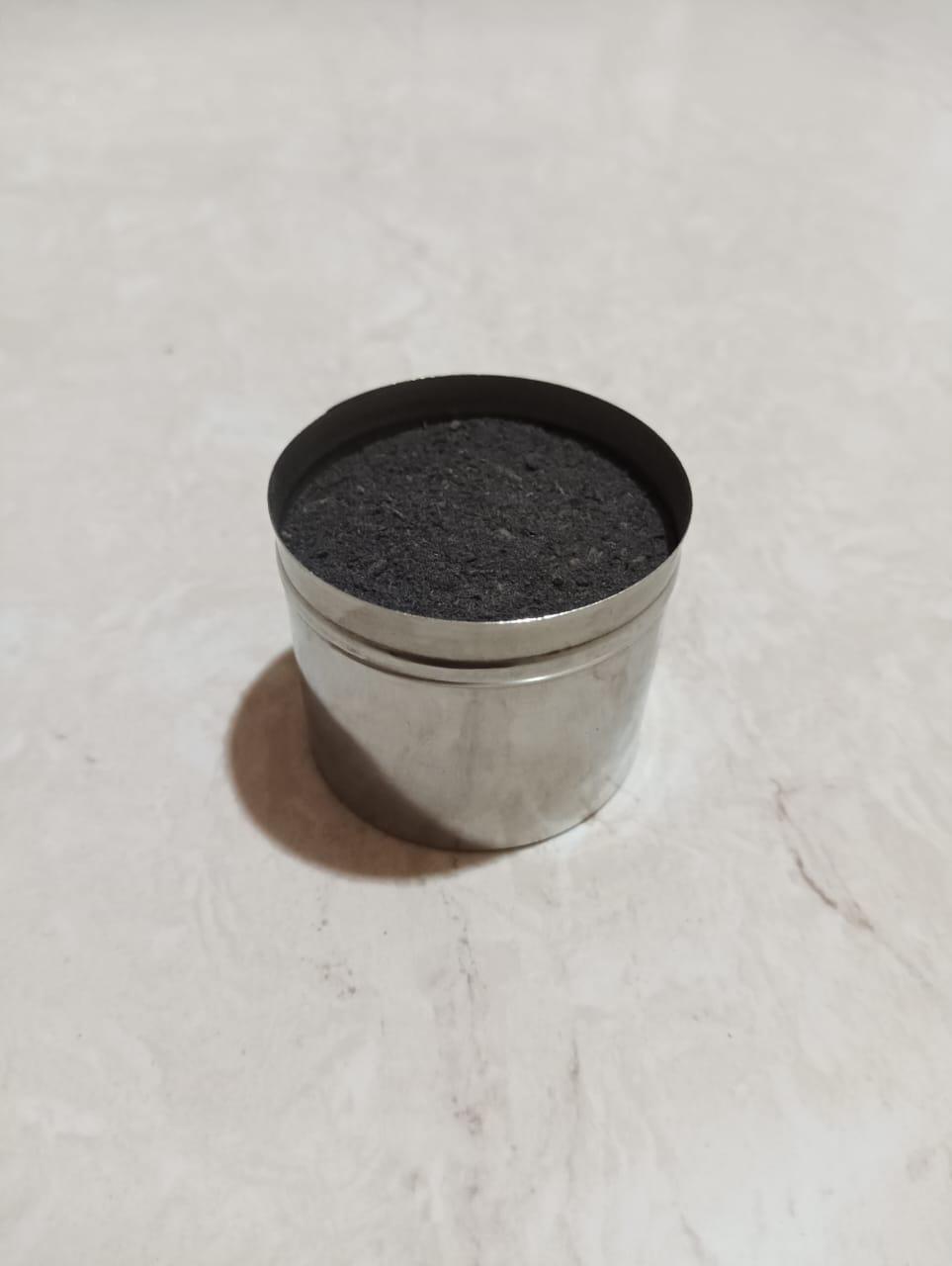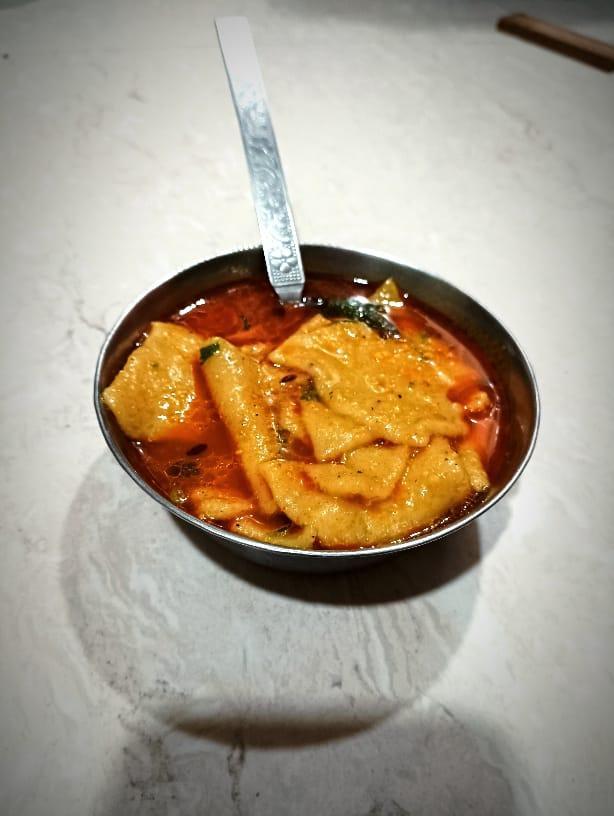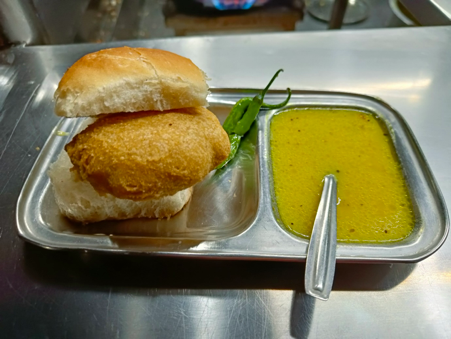Contents
- Traditional and Modern Eating Practices
- Vegetarianism and Dietary Restrictions Across Communities
- Meals of the Day
- How Spicy is the Food?
- Local Produce
- Pickles
- Baby Food and Tiffin Boxes
- Festival and Seasonal Delicacies
- Wedding Food
- Prasad and Bhandara
- Smoking, Drinking, and Substance Use
- Local Culinary Traditions
- Chakolya
- Kadhi Vada
- Sangli Special Bhel
- Chapati Bhaiji
- Eating Out
- Local Worker Cooperatives / Self-Help Groups
SANGLI
Food
Last updated on 22 July 2025. Help us improve the information on this page by clicking on suggest edits or writing to us.
Traditional and Modern Eating Practices
Over time, the food practices in Sangli district have evolved significantly. Traditionally, the local cuisine was characterised by simple and easily digestible foods. Staple dishes like Pithla-Bhakri and Chutney-Bhakri were favoured for their nutritional value and simplicity. These traditional foods remain popular among the older generation and farmers. In recent years, the food preferences in Sangli have expanded to include a wide variety of global and fast food options. Chinese dishes, pizzas, and burgers have become common, especially among the younger population.
Vegetarianism and Dietary Restrictions Across Communities
Sangli cuisine is primarily known for its vegetarian dishes. This emphasis on vegetarian options likely stems from two key factors: the district's strong agricultural base, which produces a wide variety of fresh vegetables and pulses, and the presence of significant vegetarian communities such as the Marathi Jains and Marwaris. However, Sangli is also home to some of the most delicious chicken and mutton dishes.
Meals of the Day
Mornings often begin with tea, biscuits, and toast, though heartier breakfast options like Rassa Pohe, Vada Sambar, or Misal Pav are also popular, particularly at iconic breakfast establishments such as Ganesh Nashta Centre. Lunch might feature Zunka Bhakri and Taak (buttermilk), while early evening snacks include fried delights like Vada Pav, Samosas, Kachoris, and Maska Pav. Evening meals typically consist of rice with Anda Curry (egg curry), masoor with jowar bhakri, or rice. To aid digestion, fennel seeds are commonly consumed after meals.
How Spicy is the Food?
![Mutton Kharda[1]](/media/culture/images/maharashtra/sangli/food/mutton-kharda1-8c006b6a.png)
Sangli cuisine leans towards the spicier side. Kharda (a side dish made of crushed green chillies) is known for its intense heat. This dish's prevalence in Sangli and the neighbouring Kolhapur district suggests a local preference for spicier food. Further evidence of Sangli's affinity for spice can be found in the popularity of other condiments like solan thecha, a fiery chutney made with sun-dried tomatoes and spices, and Lasun Thecha, a green chutney made with garlic and chillies.
Local Produce
Sangli district thrives on agriculture, and its rich, fertile lands produce a variety of crops from jowar, eggplants, pulses, coconut and a variety of fruits ranging from bananas, grapes, and mangoes.
![Turmericfingers[2]](/media/culture/images/maharashtra/sangli/food/turmericfingers2-9f3644b5.png)
Sangli, known as the "turmeric capital" of India, is renowned for its high-quality turmeric production, which has been cultivated in the region since the early 1900s. The area's fertile soil and favourable dry weather conditions contribute significantly to its status as a major trading centre for turmeric in Asia, accounting for nearly 80% of India's total turmeric trade. In addition to being a key spice, turmeric is featured in local culinary specialities such as olya haldicha loncha, a wet turmeric pickle that highlights its versatility. Other spices cultivated in Sangli include red chilli peppers and coriander, further enriching the region's agricultural diversity. The unique characteristics of Sangli turmeric, including its high curcumin content and distinct flavour profile, have earned it international recognition and a Geographical Indication Tag (GI) in 2018.
Pickles
![Olya Haldicha Loncha[3]](/media/culture/images/maharashtra/sangli/food/olya-haldicha-loncha3-81caada2.png)
Among its unique offerings is the wet turmeric pickle (Olya Haldicha Loncha), a local speciality made from fresh turmeric roots marinated in a blend of spices and lemon juice, celebrated for both its vibrant flavour and health benefits. Traditional pickles in Sangli also include berry pickle (Karvand), garlic pickle, and green chilli pickle, each prepared using time-honoured methods of sun-drying and spice preservation.
Baby Food and Tiffin Boxes
For infants, Ghutti, a traditional mixture of kharik (dried dates), almonds, nutmeg, and murudsheng (a type of dried fruit) mixed with milk, is spoon-fed to promote health and digestion. Additionally, cerelacs and gripe water are gaining popularity. For school-aged children, tiffin boxes typically include a balanced mix of homemade foods such as chapati, vegetables, rice, and snacks, ensuring a nutritious meal during school hours. School canteens and lunch programs also offer a variety of options, from traditional dishes to more contemporary snacks. Milk remains a staple in the diet, providing essential nutrients for growing children.
Festival and Seasonal Delicacies
One of the most beloved festival delicacies in Sangli is Puran Poli with Katachi Amti. Puran Poli is a sweet flatbread stuffed with a mixture of chana dal (split chickpeas), jaggery, and flavoured with cardamom and nutmeg. It is typically served with Katachi Amti, a tangy and spicy curry made from the strained water of cooked chana dal, seasoned with tamarind, jaggery, and a blend of spices. This combination is especially popular during the festival of Holi.
Gudi Padwa, the Maharashtrian New Year, is celebrated with Shrikhand Poori. Shrikhand is a sweet dish made from strained yoghurt, flavoured with cardamom, saffron, and sometimes garnished with dry fruits. It is typically served with fluffy, deep-fried pooris. Ukadiche Modak is also popular during Ganesh Chaturthi. These steamed rice flour dumplings are filled with a mixture of coconut and jaggery. Anarse is a sweet made during Diwali. It is prepared by fermenting dough for a few days, giving it a unique texture and flavour. During Makar Sankranti, another special dish is prepared along with Tilgul Ladoos. Bhogichi Bhaaji, a mixed vegetable curry made with seasonal vegetables like carrots, green peas, brinjal, and beans, cooked with sesame seeds, peanuts, and coconut. This dish celebrates the seasonal harvest and is typically served with bajra bhakri.

Wedding Food
Hindu weddings in Sangli district are celebrated with extensive and delectable vegetarian menus, often served on banana leaves or in thalis. The wedding feast includes a variety of traditional dishes such as Puri, Paneer Bhaaji, Talan, Dal Amti, Shrikhand, and Gulab Jamun. Masala Puri and Masale Bhaat (masala rice) add further variety to the feast. Additional dishes like Bhendi Fry, Batata Bhaaji, Koshimbir, and papad, along with various pickles, chutneys, and a refreshing fruit salad, complement the meal. The feast is accompanied by buttermilk (chaas), aiding digestion and refreshing the palate.
Prasad and Bhandara
During prasad and bhandara events in Sangli district, various traditional offerings are served to attendees. These include Khavyacha Pedha, a sweet made from khava (reduced milk solids); Bundicha Ladu, round sweets made from gram flour and sugar; Panchamrut, a mixture of milk, yoghurt, honey, ghee, and sugar; sugar with a piece of coconut, symbolising purity and sweetness; and Kandi Pedha, a regional speciality sweet.
Smoking, Drinking, and Substance Use

In Sangli, substance use is significant, particularly among impoverished communities. Desi Daru, such as the locally known Santra, is prevalent due to its affordability. Santra is made from sugarcane pulp, fermented, and distilled from molasses, often flavoured with orange. It is widely consumed by many, including drug addicts, contributing to health and social issues in the community.

Additionally, Misri, a type of smokeless tobacco, is popular among women in Sangli. It is made by roasting tobacco on dried cow dung, then grinding it into a black powder. This powder is placed in a small cylindrical box and consumed by placing a pinch in the mouth, providing a nicotine rush. Misri is a habit craved by many women in the region, despite its health risks.
Local Culinary Traditions
Chakolya

Chakolya stands out as a speciality of Tasgaon and Atpadi talukas. This homemade dish, not commonly found in commercial menus, is crafted by cooking small pieces of wheat flour dough in a kaalvana along with coconut, garlic, cumin, and coriander leaves. The result is a spicy and flavorful preparation, often prepared when fresh vegetables are scarce.
Kadhi Vada

Kadhi Vada Pav is known to be one of the specialities of Sangli. This combination of Vada Pav and Kadhi is a unique one and is not found in other districts of Maharashtra. Kadhi is essentially made up of dahi (curd) and besan (gram flour) and is usually served with hot steaming rice. This dish is also now found in cities like Pune and Kolhapur.
Sangli Special Bhel

Special Bhel is a speciality of Sangli, different from other dishes of a similar kind, as it includes a mixture of distinct bhadang wale churmuri or murmure (puffed rice), produced in Sangli itself. Other ingredients in the dish include Chinch Paani (tamarind water), green chutney, onion, coriander, groundnuts, and sev served over it. This gives the dish a nice, crispy, and tangy flavour. The rice used for making the churmuri is called Chikmagalur rice. The churmuri is made by soaking the rice grain in water for a brief period, after which they are tossed and sautéed in a hot pan or big kadhai in salt or sand, as it puffs. One can also tell the vendor to change the taste of the dish, sweet, spicy, or a blend of both.
Chapati Bhaiji

Chapati Bhaiji is another culinary speciality of Sangli, whose origin is contested between the districts of Sangli and Kolhapur. Some sources say that it originated in the border town of Jaysingpur, between Sangli and Kolhapur. The bhajji is made of onions, chillies and potatoes, mixed in a batter of besan (gram flour). This mixture is then deep-fried in hot oil. It tastes best when accompanied by spicy fried chilli, onion slices, and a hot cup of tea.
Eating Out
Some restaurants, such as Abhishek, Sai Prasad, and Ruchi Sangam, have been serving a well-known vegetarian thali for over a century. The traditional thali includes two varieties of vegetables: the classic Bharli Vangi Bhaaji (eggplant/brinjal) along with another vegetable, usually potato; Amti (lentil curry); Koshimbir (green salad with curd); papad; and yoghurt. Hot chapatis are served alongside rice. Given that the dairy industry is one of the primary sectors in the district, various types of sweets accompany the meal. The famous Basundi (condensed milk flavoured with cardamom) is served as a dessert, along with several other options like fruit custard and Gulab Jamun. These thalis are typically offered at a fixed price, with no limit on the quantity or number of servings. Interestingly, in some restaurants, a fine is imposed if anyone wastes food.
Local Worker Cooperatives / Self-Help Groups
In Sangli district, local worker cooperatives and self-help groups play a significant role in sustaining and promoting traditional snacks like Bhadang. Amba Bhadang is a spicy snack made with kurmura or puffed rice, peanuts, dried coconut (kopra), and spiced with red chilli powder and sugar. It is a favourite across India, especially in Sangli and Kolhapur. These cooperatives and groups are instrumental in preserving local culinary traditions and providing economic opportunities to local communities. They produce and distribute bhadang and other snacks, ensuring that these traditional delicacies continue to be enjoyed locally and beyond. Bhadang can be savored on its own or paired with tea, and is sometimes enhanced with chopped onions, coriander, and a squeeze of lemon juice for added flavor.
Last updated on 22 July 2025. Help us improve the information on this page by clicking on suggest edits or writing to us.